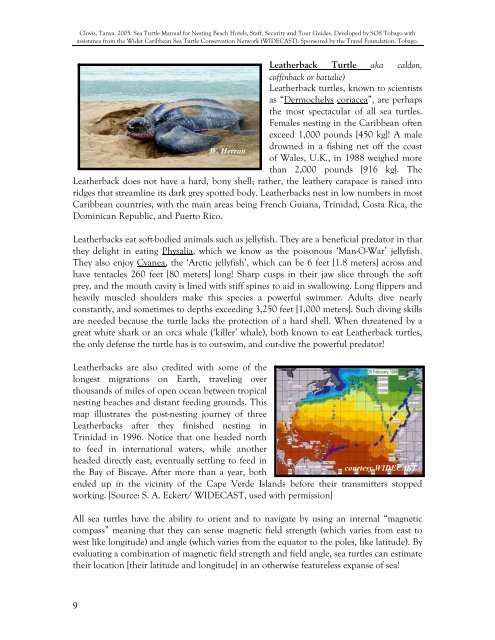Clovis, Tanya. - WIDECAST
Clovis, Tanya. - WIDECAST
Clovis, Tanya. - WIDECAST
You also want an ePaper? Increase the reach of your titles
YUMPU automatically turns print PDFs into web optimized ePapers that Google loves.
<strong>Clovis</strong>, <strong>Tanya</strong>. 2005. Sea Turtle Manual for Nesting Beach Hotels, Staff, Security and Tour Guides. Developed by SOS Tobago with<br />
assistance from the Wider Caribbean Sea Turtle Conservation Network (<strong>WIDECAST</strong>). Sponsored by the Travel Foundation. Tobago.<br />
Leatherback Turtle aka caldon,<br />
coffinback or battalie)<br />
Leatherback turtles, known to scientists<br />
as “Dermochelys coriacea”, are perhaps<br />
the most spectacular of all sea turtles.<br />
Females nesting in the Caribbean often<br />
exceed 1,000 pounds [450 kg]! A male<br />
drowned in a fishing net off the coast<br />
W. Herron<br />
of Wales, U.K., in 1988 weighed more<br />
than 2,000 pounds [916 kg]. The<br />
Leatherback does not have a hard, bony shell; rather, the leathery carapace is raised into<br />
ridges that streamline its dark grey spotted body. Leatherbacks nest in low numbers in most<br />
Caribbean countries, with the main areas being French Guiana, Trinidad, Costa Rica, the<br />
Dominican Republic, and Puerto Rico.<br />
Leatherbacks eat soft-bodied animals such as jellyfish. They are a beneficial predator in that<br />
they delight in eating Physalia, which we know as the poisonous ‘Man-O-War’ jellyfish.<br />
They also enjoy Cyanea, the ‘Arctic jellyfish’, which can be 6 feet [1.8 meters] across and<br />
have tentacles 260 feet [80 meters] long! Sharp cusps in their jaw slice through the soft<br />
prey, and the mouth cavity is lined with stiff spines to aid in swallowing. Long flippers and<br />
heavily muscled shoulders make this species a powerful swimmer. Adults dive nearly<br />
constantly, and sometimes to depths exceeding 3,250 feet [1,000 meters]. Such diving skills<br />
are needed because the turtle lacks the protection of a hard shell. When threatened by a<br />
great white shark or an orca whale (‘killer’ whale), both known to eat Leatherback turtles,<br />
the only defense the turtle has is to out-swim, and out-dive the powerful predator!<br />
Leatherbacks are also credited with some of the<br />
longest migrations on Earth, traveling over<br />
thousands of miles of open ocean between tropical<br />
nesting beaches and distant feeding grounds. This<br />
map illustrates the post-nesting journey of three<br />
Leatherbacks after they finished nesting in<br />
Trinidad in 1996. Notice that one headed north<br />
to feed in international waters, while another<br />
headed directly east, eventually settling to feed in<br />
courtesy <strong>WIDECAST</strong><br />
the Bay of Biscaye. After more than a year, both<br />
ended up in the vicinity of the Cape Verde Islands before their transmitters stopped<br />
working. [Source: S. A. Eckert/ <strong>WIDECAST</strong>, used with permission]<br />
All sea turtles have the ability to orient and to navigate by using an internal “magnetic<br />
compass” meaning that they can sense magnetic field strength (which varies from east to<br />
west like longitude) and angle (which varies from the equator to the poles, like latitude). By<br />
evaluating a combination of magnetic field strength and field angle, sea turtles can estimate<br />
their location [their latitude and longitude] in an otherwise featureless expanse of sea!<br />
9
















